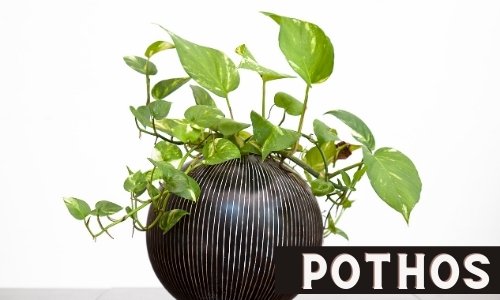Please note that this post may contain affiliate links. You can read my full affiliate disclosure at the bottom of the page.
You might have a house that just doesn’t get much direct sunlight through the windows. Or perhaps you have a room without much natural light. If so then you would need an indoor plant that doesn’t need sunlight. And if you are anything like me, you probably want something that is easy to care for too.
In this post, I go over some of the houseplants that are common, easy to find, easy to care for, and don’t need a bunch of light to thrive.

Houseplants That Don’t Need Sunlight
- Coleus
- Heartleaf Philodendron
- Pothos Plants (Devil’s Ivy)
- Snake Plant (Mother-In-Law’s Tounge)
- Peace Lily
- Madagascar Dragon Tree
Coleus

Coleus plants are very hardy and easy to take care of house plant that does great without direct sunlight. Many coleus plants can do well in a part of the house where windows don’t face the sun at any part of the day but they still get direct light during the daytime.
Coleus plants just need a few things when growing indoors. You need a good quality potting soil in a well draining pot and watering will be needed every 2 to 3 days.
You can easily propagate new coleus plants by using stem cuttings from your current plant.
Coleus plants are toxic to animals, so make sure you keep them out of reach of your furry house mates.
Heartleaf Philodendron

Heartleaf Philodendron, aka Philodendron Hederaceum, was discovered to be an easy to propagate plant. After this discovery, philodendrons became a very popular houseplant due to it’s easy care and easy propagation.
Originally this plant was found in tropical forests, and it would grow by climbing up trees. The large trees of the tropical rain forests would shade it from getting direct sunlight, so it has adapted to lower light levels.
Heartleaf philodendron does not like direct sunlight. So you never want to put it in a window that would get sunlight all day. Indirect light is best for this houseplant.
One of the things plant lovers like about the heartleaf philodendron is it’s climbing vines. You can direct these vines where you want them to grow. Some people like to make the plant climb around the top of a room. Or even be the main feature on a wall.
You can easily propagate a heartleaf philodendron using cuttings from the plant and placing it in a glass of water. Once the roots grow you can report into a new pot or even repot with the main plant to make it look fuller.
It is toxic to cats and dogs, so make sure you keep it out of reach of pets.
Pothos Plants

Pothos, aka Devil’s Ivy, is a very easy to care for houseplant. They are very popular in offices or bathrooms due to their ability to grow with lack of natural direct light. They also help clean the air according to a NASA Clean Air Study.
You can grow a pothos plant in a room that has low light or bright indirect light. The only thing to look out for with a pothos plant, if you have one that is highly variegated, with white, it might not tolerate low light as well as one that is mostly green.
They are not a picky plant when it comes to anything, they tolerate just about any light. Pothos can grow well in just about any quality of the soil. However, it will thrive better in good quality soil.
Pothos can also grow with out soil, you can just stick the plant directly in water and it will grow just fine.
You can get your pothos to grow faster by fertilizing the plant every 2 to 3 months.
If you want to make new pothos plants, it is very easy to do with cuttings from your current pothos. When propagating a pothos plant from cuttings just remember that it is best if you are going to have your pothos plant in soil, then start your cutting in soil. And if you are going to keep your new pothos in water, then start your pothos cutting in water. Pothos plants don’t do well being switched from water to soil or from soil to water.
Pothos are another plant that are toxic to pets, so make sure they are out of reach of your furry housemates.
Pothos Articles:
Pothos Care Guide: How To Take Care of A Pothos Plant
How to Propagate Pothos Plants in Water from Cuttings
Are Pearls and Jade Pothos Slow Growing Plants?
Snake Plant

If you find yourself being a serial plant killer, then a Snake Plant, aka Mother-In-Laws Tounge, might be the right fit for your.
Snake Plants can take weeks of neglect and keep pushing through.
And if you have a room that is darker and doesn’t get much light, then a snake plant can take that too. In addition to doing ok in low light, they can make it through drought and even make it through insect pests.
The other bonus of a snake plant, like pothos plants, is that they have been shown by research to help keep the air clean by removing toxins.
It is best to make sure you let your snake plant soil dry out between watering. And you can use a general plant fertilizer in the pot to help give it nutrients.
If you want to propagate your snake plant, the easiest way is to wait until your current snake plant grows a rhizome. It will look like another baby snake plant in the same pot. You can take the plant out of the pot and cut off the rhizome with a sharp knife. Then stick it in its own pot and you’ll have a new Mother-In-Laws Tounge plant.
Peace Lily

Peace Lilies are another popular office plant due to their ability to grow just fine in low to medium light. They even do well growing in fluorescent light.
The only drawback to low light areas with a peace lily, is that it will cause it not to flower as much as a peace lily with more light.
Peace lilies are another one of the plants found to help clean the air too.
The main thing a peace lily needs you to play close attention to is watering. They are more tolerant to underwatering than overwatering. Some people even will wait until the leaves begin to droop to water their peace lily.
Another common care that a peace lily will need is to make sure to keep it’s large leaves wiped off to help keep them from getting a dust build up.
You won’t need to fertilize a peace lily often either, just one to two times per year will be enough.
Madagascar Dragon Tree

The Madagascar Dragon Tree (Dracaena Marginata) is one of those easy to care for houseplants that have been in houses for decades and their popularity never seems to wane. They are a slender and tall plant, that is great when you have a place to put a plant that just seems to grow up and not out.
Dragon Trees like low to medium light, and do not do well if they are in a place that gets direct sunshine. So never place these in a window that has sunlight coming through it for most of the day.
If you do end up putting it in a place that gets too much light you will be able to tell by the leaves of the plant. A dragon tree that is getting too much sun will have scorched looking leaves. If there is not enough light then the leaves will look short and limp.
The watering needed for a Madagascar Dragon Tree varies by the season. You will want to make sure to keep the soil moist in the spring and summer. For the fall and winter, you will want to cut back on the watering.
Fertilizing needs to be done monthly during the spring and summer. For fall and winter only fertilize once or twice during that time.


